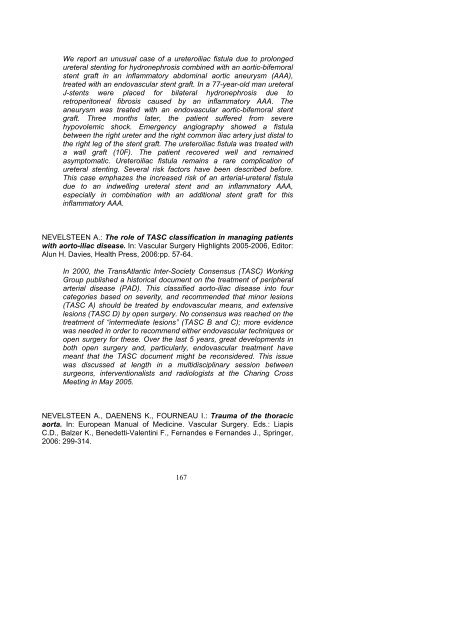2006 - UZ Leuven
2006 - UZ Leuven
2006 - UZ Leuven
You also want an ePaper? Increase the reach of your titles
YUMPU automatically turns print PDFs into web optimized ePapers that Google loves.
We report an unusual case of a ureteroiliac fistula due to prolongedureteral stenting for hydronephrosis combined with an aortic-bifemoralstent graft in an inflammatory abdominal aortic aneurysm (AAA),treated with an endovascular stent graft. In a 77-year-old man ureteralJ-stents were placed for bilateral hydronephrosis due toretroperitoneal fibrosis caused by an inflammatory AAA. Theaneurysm was treated with an endovascular aortic-bifemoral stentgraft. Three months later, the patient suffered from severehypovolemic shock. Emergency angiography showed a fistulabetween the right ureter and the right common iliac artery just distal tothe right leg of the stent graft. The ureteroiliac fistula was treated witha wall graft (10F). The patient recovered well and remainedasymptomatic. Ureteroiliac fistula remains a rare complication ofureteral stenting. Several risk factors have been described before.This case emphazes the increased risk of an arterial-ureteral fistuladue to an indwelling ureteral stent and an inflammatory AAA,especially in combination with an additional stent graft for thisinflammatory AAA.NEVELSTEEN A.: The role of TASC classification in managing patientswith aorto-iliac disease. In: Vascular Surgery Highlights 2005-<strong>2006</strong>, Editor:Alun H. Davies, Health Press, <strong>2006</strong>:pp. 57-64.In 2000, the TransAtlantic Inter-Society Consensus (TASC) WorkingGroup published a historical document on the treatment of peripheralarterial disease (PAD). This classified aorto-iliac disease into fourcategories based on severity, and recommended that minor lesions(TASC A) should be treated by endovascular means, and extensivelesions (TASC D) by open surgery. No consensus was reached on thetreatment of “intermediate lesions” (TASC B and C); more evidencewas needed in order to recommend either endovascular techniques oropen surgery for these. Over the last 5 years, great developments inboth open surgery and, particularly, endovascular treatment havemeant that the TASC document might be reconsidered. This issuewas discussed at length in a multidisciplinary session betweensurgeons, interventionalists and radiologists at the Charing CrossMeeting in May 2005.NEVELSTEEN A., DAENENS K., FOURNEAU I.: Trauma of the thoracicaorta. In: European Manual of Medicine. Vascular Surgery. Eds.: LiapisC.D., Balzer K., Benedetti-Valentini F., Fernandes e Fernandes J., Springer,<strong>2006</strong>: 299-314.167

















